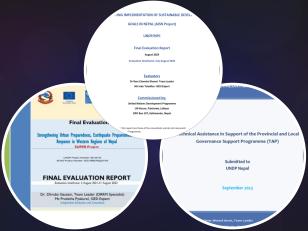Evaluation Reports
Evaluation Reports
November 21, 2023
Key Takeaways from the evaluation report are as follows:
SUPER
- The SUPER Project demonstrated a model disaster risk governance arrangements at sub-national levels to cater the need arose from the ongoing federalization process, which created/restructured governance arrangements in Nepal.
- The project developed several policy and technical documents with the aims to standardize and institutionalize disaster preparedness in project provinces and municipalities, which include the Provincial Earthquake Resposne Framework, the Business Continuity Plans, Manuals on fire response and safe construction practices, and the women safety audit.
- The creation and strengthening of the Emergency Operation Centres (EOCs) at province and municipal levels together with strengthening of cluster mechanism at province levels in partnership with government and the RC Office is geared to improve disaster response and coordination.
- An event triggering a disaster can be same but it impacts differently to different sections of the society. The ECHO supported SUPER project tried to meet specific disaster preparedness needs of diverse community for truly inclusive. The project consortium of UNDP, UNICEF and UN Women partnering the Nepal Red Cross Society, the Social Awareness Center (SAC), the Rural Women’s Development and Unity Centre (RUWDUC) and the Legal Aid and Consultancy Centre, etc. helped in deeper understanding of vulnerability and better reach of preparedness intervention.
- The retrofitting of houses of vulnerable groups to demonstrate significance of seismic risk reduction together with mass awareness has led to project municipalities to contribute its resources to retrofit additional houses, thus a step towards upscaling.
- The project contributed to several innovative interventions such as the housing insurance by municipalities to transfer risk, small infrastructure measures such as reviving well to act as fire hydrant, etc. which can be replicated and upscaled.
ACCELERATING IMPLEMENTATION OF SUSTAINABLE DEVELOPMENT GOALS IN NEPAL (AISN Project)
- AISN project has been well-owned by government agencies. UNDP, being a neutral organization with a strong legacy of working on SDG globally, has added value to engaging the government and other stakeholders on SDG localization in Nepal. The project has provided instrumental support to the government of Nepal in raising awareness of SDGs at the national level, helped in improving policy & institutional framework and built the capacity of stakeholders along with a huge set of knowledge required for SDG localization. The intervention has also helped to comprehend various challenges and opportunities related to SDG implementation while working with a diverse range of stakeholders. The project has generated some good learning which is inevitable for SDGs-related planning and programming in the future.
- SDGs localization is also dependent on the quality of stakeholder engagement. The active collaboration of stakeholders improves ownership and creates engagement. Based on the experience from this project, there is a need for a result-oriented engagement and collaborative actions with the private sector, CSO and cooperatives along with society and citizens. This is all about who decides for whom and why. This concept is important to further strengthen the ‘Leave No One Behind (LNOB)’ approach.
- Nepal has made continuous progress on the SDGs achievement, and it still needs significant support in further strengthening the enabling environment and institutions for the localization of SDGs. In addition, support is needed to fill the SDG investment gap and capacity-building for promoting prosperity.
- Future support should also emphasize social and economic development issues such as promoting human assets (indicators of nutrition, health, school enrolment and literacy); and reducing economic vulnerability (indicators of natural and trade-related shocks, physical and economic exposure to shocks, and smallness and remoteness).
- The SDGs are not going to be achieved with the conventional approach of development planning and management alone. Future support should also consider the prosperity pillar of SDGs to ensure ‘access to prosperous and fulfilling lives in harmony with nature’. Nepal is going to graduate from LDC in 2026 which may impact trade and other financial support that Nepal is, so far, entitled to receive.
Technical Assistance in Support of the Provincial and Local Governance Support Programme (TAP)
Key Takeaways
- TAP project has shown significant progress in achieving the scope of activities set by its’ initial plans and proDoc. The project was relevant to the national, provincial, and local levels priorities, SDGs, UNDP’s CPDs, etc. Moreover, the TAP has been able to provide the required TA staff to the PCU, PCGGs and PPIUs as planned.
- n terms of project’s efficiency, overall TAP was found as efficient whereby the TASC played its role of project board efficiently as well as the overall budget efficiency was efficient, despite the challenges of slow adoption of federalism and ownership at provincial and local levels.
- In view of newly introduced federal governance, maintaining intergovernmental relationships between provinces and local levels is one of the positive changes or impacts that TAP’s support has contributed.
- The immense transition of federalism in any country with such a comprehensive technical assistance exercise require both administrative and behaviour change through a well thought of change management component in the program along with adequate tools and resources.
- The coordination mechanism defined in planning stage like P-TACC would have an optimum mechanism to resolve coordination challenges between PCGGs and PPIU.

 Locations
Locations





